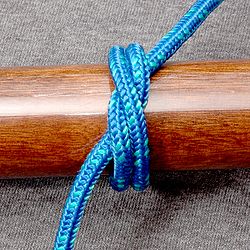
B: A closed loop
C: Turn or single turn
D: Round turn
E: Two round turns
A turn is one round of rope on a pin or cleat, or one round of a coil. [6] Turns can be made around various objects, through rings, or around the standing part of the rope itself or another rope. A turn also denotes a component of a knot.
Contents
When the legs of a loop are brought together and crossed, the rope has taken a turn. [7] One distinguishes between single turn, round turn, and two round turns depending on the number of revolutions around an object. The benefit of round turns is best understood from the capstan equation.

